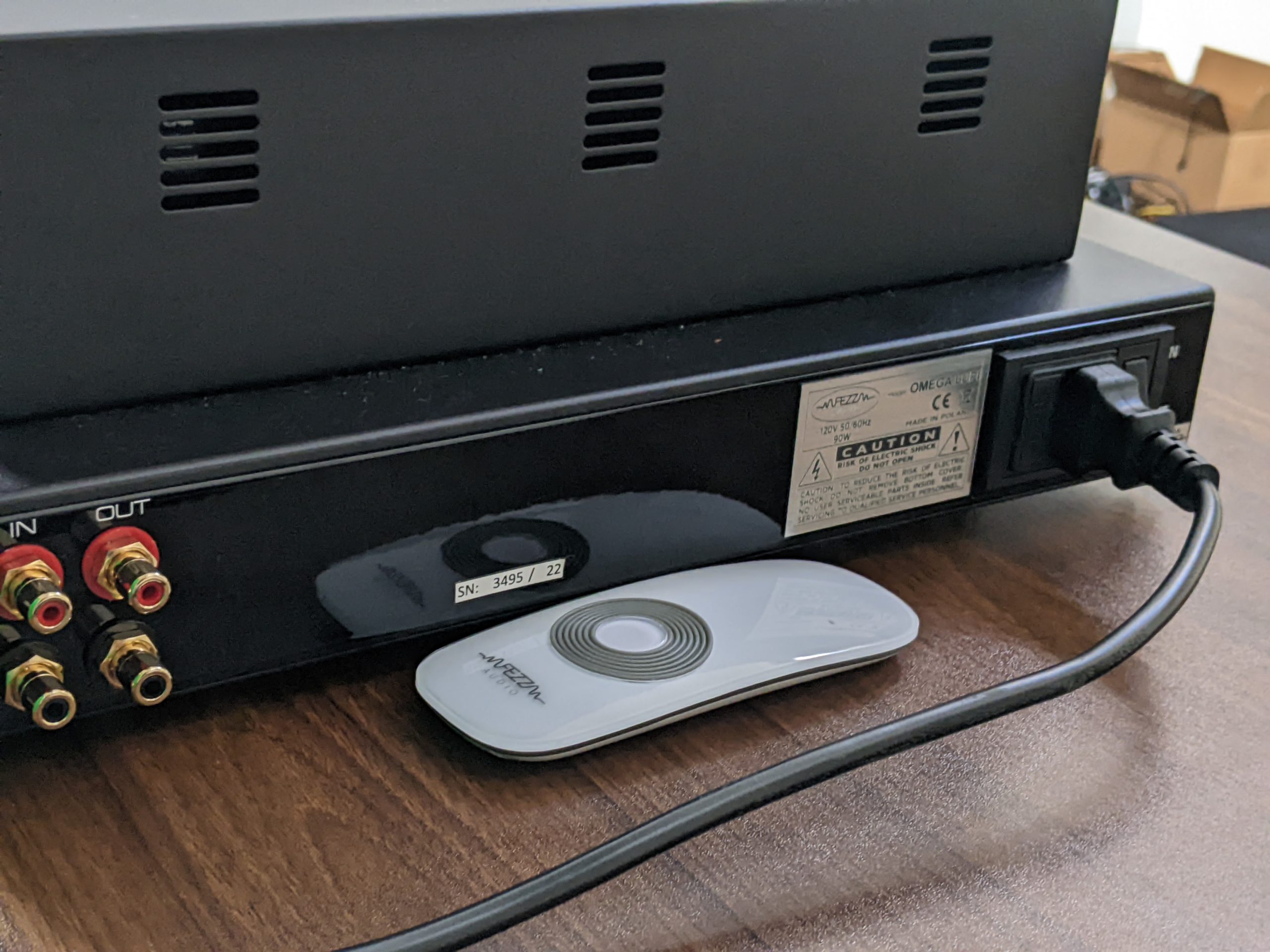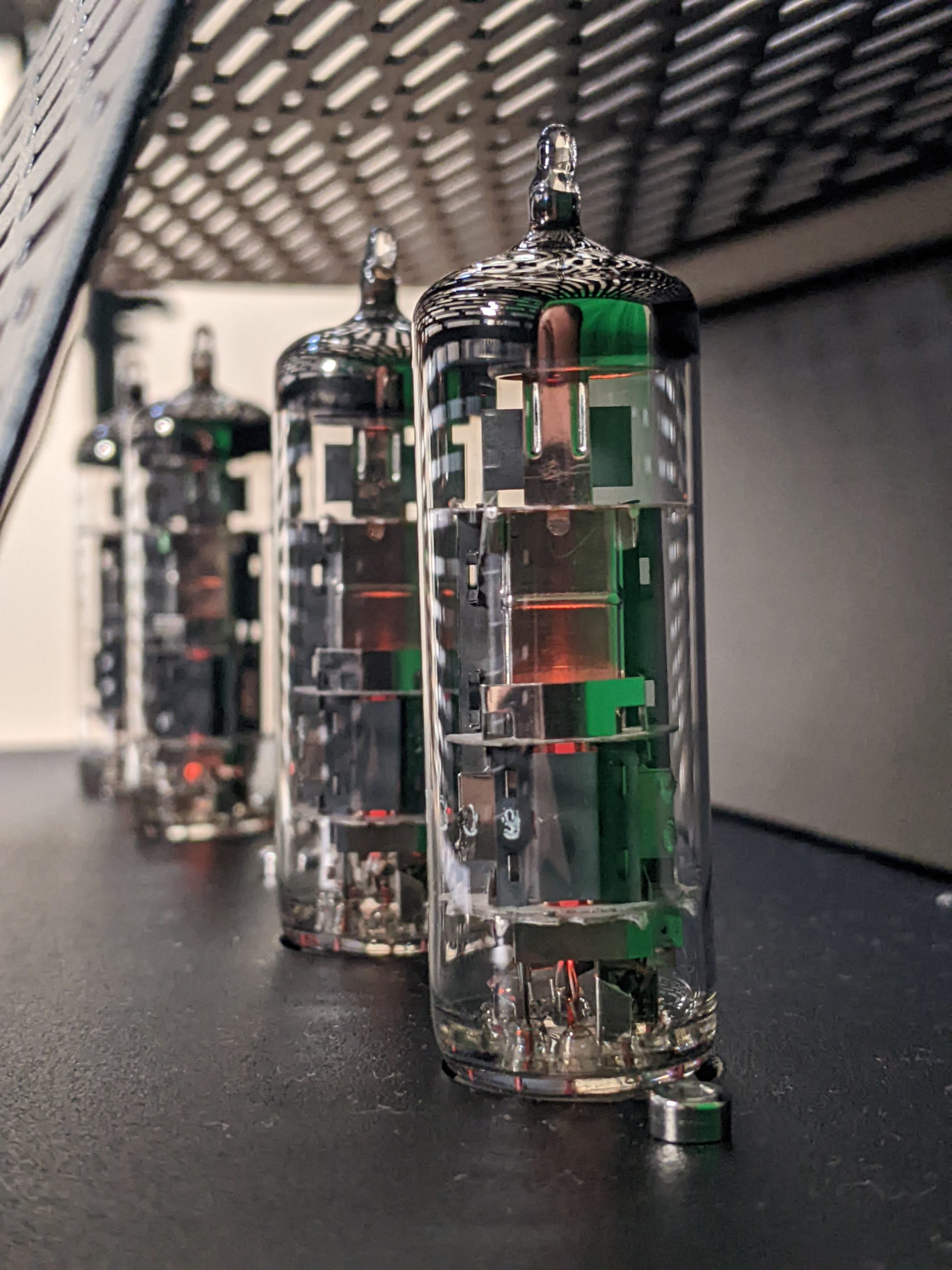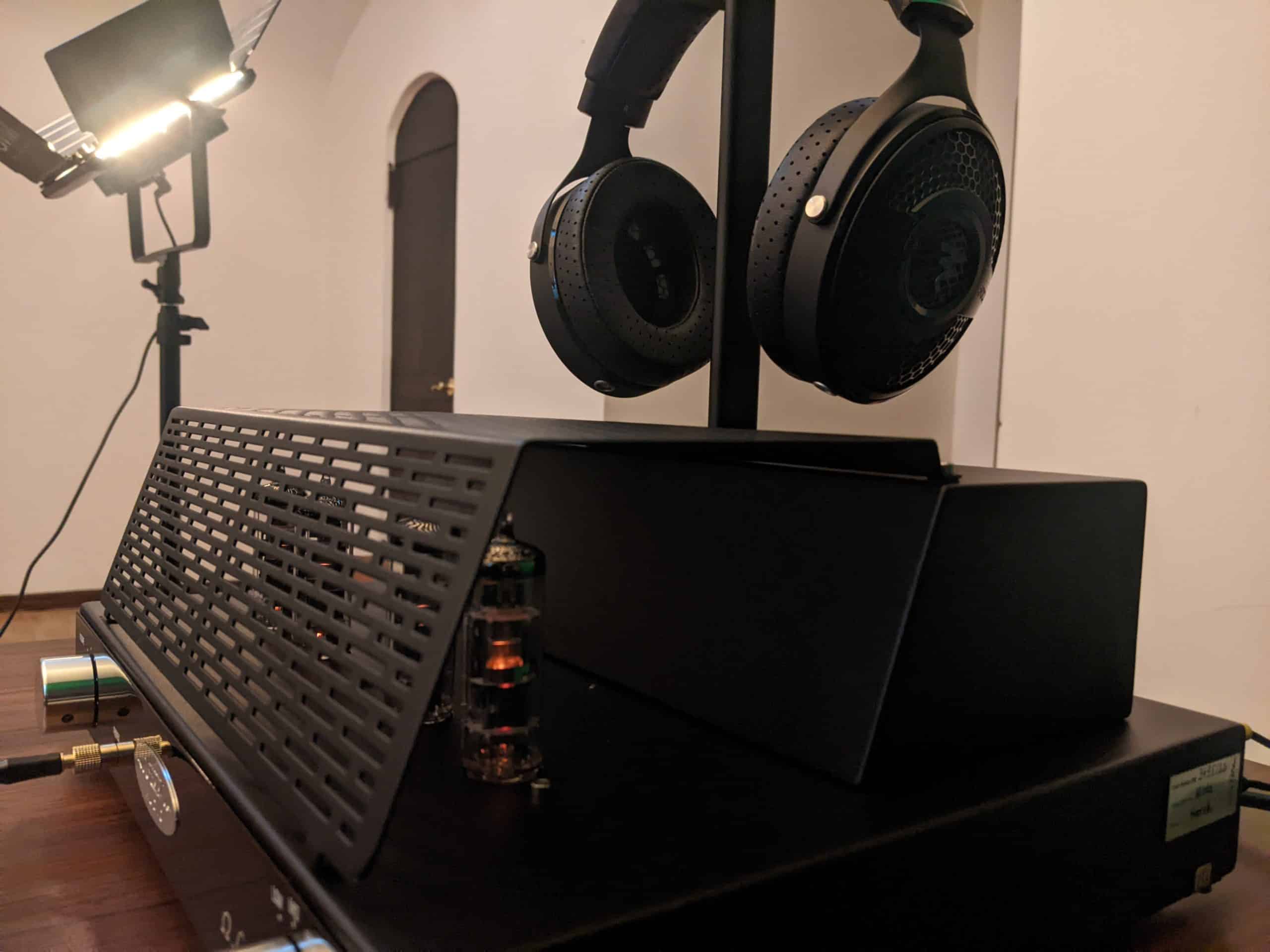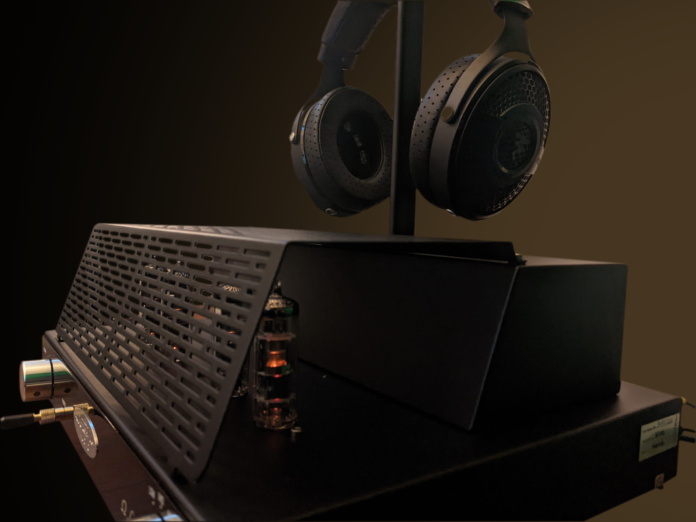Fezz Audio Omega Lupi Headphone Amp Review
One look at Fezz Audio’s homepage conveys what you need to know about the company: they specialize in a variety of amplifiers – and take their craft seriously. Today, I’m concerned with one of only two tube headphone amp offerings from the Polish audio company, the Fezz Audio Omega Lupi. I’ll go over some basics, some tech, and some specs before I get into my (rather pleasant) experience with the Omega Lupi tube amp.
What’s In the Box?

- Fezz Audio Omega Lupi Tube Headphone Amplifier
- (4) PCL86 Vacuum Tubes
- Vacuum Tube Protective Cage
- Cotton Gloves
- User Manual
- Remote control + battery
Look and Feel

The Fezz Audio Omega Lupi features vintage fonts and a sturdy, modern, metallic build. The unit I’m using for this review is in the “Black Ice” color scheme, but the company also offers “Big Calm,” which is a little more vintage looking in its mahogany color. The amp has the sort of premium-yet-understated look that, with a nod and a wink, lets you know that it’s a pretty luxurious product. Once I went through the fairly simple set up, I found it self apparently well crafted: no loose parts, everything firmly in its place and ready to go. The volume control knob was smooth, not particularly sensitive, and was conducive to fine tuning my preferred listening volumes. “Phones Impedance” is the only other control knob on the front of the unit, and its power switch located on the rear next to the power chord socket. The vacuum tube protective cage is optional; recommended for safety purposes, but feel free to leave it off if you want to see that satisfying amber glow radiating from the tubes.
A brief note on my set up experience, in case you find yourself with the Omega Lupi in your listening room: the tubes faced a surprising degree of resistance when I was placing them in their appropriate sockets. After triple checking that I was putting the right tube in the right position, I carefully applied a little more pressure than I thought I would have to, and felt the tube slowly and firmly work its way into the socket. I didn’t find this much of a grievance, just something a reader can learn from my experience.
Technical Overview and Specs

The Fezz Audio Omega Lupi uses four PCL86 Vacuum tubes to achieve its amplification. It has RCA in and RCA out on its rear, and one 6.35mm unbalanced headphone output on its front. The Lupi is designed to power headphones that are between 32 and 600 ohms, and includes 3 settings on its “Phones Impedance” knob to accommodate this range. According to Fezz Audio, “Low” is meant for 32 ohm headphones, “Mid” for up to 150 ohms, and “High” for 150-600 ohms. I’ll get into my personal experience with these settings in a moment.
|
Spec |
Fezz Audio Omega Lupi |
|
Type |
Stereo Vacuum Tube Headphone Amp |
|
Max Output |
2 x 250 mW |
|
Circuit Type |
Push-pull AB1 Class |
|
Output Impedance |
32 – 600 ohms |
|
Harmonic distortion |
<0.3% |
|
Frequency Response |
20 Hz – 90 kHz |
|
Power Consumption |
90W |
|
Weight |
9.5 kg |
|
Dimensions |
340x355x150mm |
|
Tubes |
(4) PLC84 |
Technical Performance
Before I talk about the Lupi’s more colorful sonic features, I’ll go over some of the important basics that should be discussed of any headphone amp.
So, can the Lupi perform its base function of adequately powering high impedance headphones? The answer to that question is a definitive and emphatic yes. For starters, it was capable of amplifying 600 ohm Beyerdynamic DT 880 headphones to volume levels that were too loud for me to comfortably listen to, and still had quite a bit of room left to go. While Fezz Audio recommends the “Mid” impedance setting for headphones above 32 ohms, I found that “Low” was more than sufficient to bring a pair of 80 ohm Focal Utopia 2022 headphones well beyond bearable listening levels. I’m left with the impression that the Fezz Audio Omega Lupi can easily power virtually any headphone you give it.
What about noise floor? There was a very faint level of analog “hiss” present, though it was more pleasant than that word implies – comparable to the background noise you might hear on a vinyl record. This noise was only noticeable without music playing, and became imperceptible the moment I pressed play. I found a couple of factors determined the volume of this hiss: 1) It was loudest when the volume knob was in a center position, and was quietest when it was at a lower or higher volume position. 2) The higher the amp’s impedance setting, the quieter this noise became. Once again, this is a feature that didn’t bother me at all, and it’s fairly typical of tube headphone amps; I mention it only as a relevant observation.
Last thing I want to mention here is that burn-in was absolutely necessary with the Lupi. Just thirty minutes of burn in made an enormous difference in both power output and tonality. So, needless to say: If you find yourself with the Lupi in your home set up, contain your excitement, and give it at least several hours to warm up and find its bearings.

Sound Impressions
I tested the Fezz Audio Omega Lupi with a variety of headphones.
I listened with:
- The Focal Utopia 2022: 80 ohms, warm neutral
- Sennheiser HD 800: 300 ohms, analytical
- Meze Audio 109 Pro: 40 ohms, bright and trebly
- Sennheiser HD 660: 150 ohms, analytical
- Beyerdynamic DT 880: 600 ohms, dark-analytical
Overall, the Fezz Audio Omega Lupi is equal parts dense and detailed. Low mids and high bass seemed to be the focus of the Lupi’s colorations, while center mids and treble were secondary beneficiaries. This isn’t to say the Lupi simply amplified these regions: though some degree of extra amplitude seemed present in high bass frequencies, what really drew my attention to this frequency range was how the Lupi seemed to heighten its resolution, and impart a timbre that I can only describe as a coursing energy – the sort of warm, liquid sound of submerging your head in ocean waves. This energetic detail enhancement was a little less prominent in the center mids, but was something I started to notice on electric guitars after a longer period of listening.
Listening with the Meze 109 Pro brought the most out the Omega Lupi’s effects on treble. Again, this didn’t have much to do with changes in amplitude on specific frequencies, but rather a sharpened timbre and detail. There are times where the 109 Pro can come off a bit peaky when I’m listening to it through my phone’s dongle, or even on my desktop Focusrite interface. The Lupi didn’t make this treble less intense, per se, but seemed to bring out the best of its qualities: the moderate ringing “pain” I can sometimes experience with the 109 Pro during reverb swells, for example, was replaced by an acute detail retrieval that reached deep into the high treble. This extra resolve yielded more than just tonal benefits, and gave high frequency details a more compelling sense of distance and proximity. I would compare my experience here to going to the eye doctor thinking that my glasses’ prescription hasn’t changed, only to try on some newer lenses an re-realize what having 20-20 vision is like.
As I would expect from a tube headphone amp like the Fezz Audio Omega Lupi, there were pretty clear enhancements to sound stages. I found this particularly noticeable when listening with the Focal Utopia 2022. I generally find the Utopia’s soundstage to be impressive, but distinctly forward facing (a bit like a near field monitor listening experience, as I’ve described it before). The Omega Lupi rounded the stage out into a more concave shape, giving hard pans a sensation of coming directly from my sides rather than from a front-facing angle towards my face.
The more analytical and light-on-bass Sennheiser headphones that I tried with the Lupi took on more physically-felt qualities. Both the HD 660 S and HD 800 S had more of a rumble present in their low ends. I wouldn’t necessarily attribute this to any sort of sub or mid bass amplification, but rather firmed-up their already-existing low end profiles that added extra force to their drivers’ movements. It made their serious, reference-grade tone a little more fun and emotional – music I could feel instead of just hear in the transparent detail these classics have to offer.
Overall

The Fezz Audio Omega Lupi tube headphone amp has quite bit going for its package. To summarize for those of you skipping to this part of the review, it offered more than enough power for every headphone I threw at it. Tonal enhancements and colorations were performed tastefully, focusing more on resolve and detail of select frequency ranges (high bass in particular) rather than making intrusive EQ changes. Soundstages were undeniably widened and rounded, even with headphones that have impressive stages as-is. Topping it all off is an elegant and sturdy design that can make simply adjusting a volume knob a very satisfying experience (bonus points if you use the cotton gloves while you do it). The Omega Lupi made writing this review a pretty classy and pleasurable experience; it’s the kind of unit that I’m saddened to have to put back in its box.
You can order The Fezz Audio Omega Lupi tube headphone amplifier here from Audio46.
Compare the ranking of various headphones, earbuds and in-ear monitors using our tools.
Discuss this, and much more, over on our forum.
---MAJORHIFI may receive commissions from retail offers.















